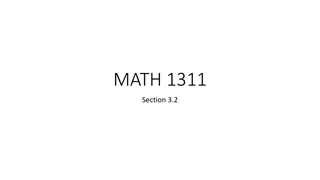Solving Systems of Linear Equations: Methods and Applications
Explore various methods for solving systems of linear equations, including the Equal Values Method and solving by inspection. Work through examples involving plant growth rates, job application tests, messy fractions, and more. Understand how to compare coefficients, constants, and graph equations to verify solutions. Apply these concepts to solve different systems of equations efficiently.
Download Presentation

Please find below an Image/Link to download the presentation.
The content on the website is provided AS IS for your information and personal use only. It may not be sold, licensed, or shared on other websites without obtaining consent from the author.If you encounter any issues during the download, it is possible that the publisher has removed the file from their server.
You are allowed to download the files provided on this website for personal or commercial use, subject to the condition that they are used lawfully. All files are the property of their respective owners.
The content on the website is provided AS IS for your information and personal use only. It may not be sold, licensed, or shared on other websites without obtaining consent from the author.
E N D
Presentation Transcript
You have been introduced to systems of linear equations that are used to represent various situations. You have used the Equal Values Method to solve systems algebraically. Just as in linear equations you found that sometimes there were no solutions or an infinite number of solutions, today you will discover how this same situation occurs for systems of equations.
5-52 Sara has agreed to help with her younger sister s science fair experiment. Her sister planted string beans in two pots. She is using a different fertilizer in each pot to see which one will grow the tallest plant. Currently, plant A is 4 inches tall and grows 2 3inch per day, while plant B is 9 inches tall and grows 2inch per day. If the plants continue growing at these rates, in how many days will the two plants be the same height? Which plant will be tallest in six weeks? Write a system of equations and solve. 1
5-53 Felipe applied for a job. The application process required him to take a test of his math skills. One problem on the test was a system of equations, but one of the equations not in y = mx + b form. The two equations are shown below. y =2 5x 5 3x + 2y = 9 Work with your team to find a way to solve the equations using the Equal Values Method.
5-54 Using the Equal Values Method can lead to messy fractions. Sometimes this cannot be avoided. But some systems of equations can be solved by simply examining them. This approach is called solving by inspection. Consider the two cases below. Case I: 3x + 2y = 2 3x + 2y = 8 Case II: 2x 5y = 3 4x 10y = 6
a) b) Compare the left sides of the two equations in Case I. How are they related? Use the Equal Values Method for solving a system of equations, write a relationship for the two right sides of the equations in Case I, and explain your result. Graph the two equations in Case I to confirm your result for part (b) and to see how the graphs of the two equations are related. Recall that a coefficient is a number multiplied by a variable and that a constant term is a number alone. Compare the coefficients of x , the coefficients of y, and the two constant terms in the equations in Case II. How is each pair of integers related? Half of your team should multiply the coefficients and constant term in the first equation of Case II by 2 and then solve the system using the Equal Values Method. The other half of your team should divide all three values in the second equation of Case II by 2 and then solve using the Equal Values Method. Compare the results from each method. What does your result mean? Graph the two equations in Case II to confirm your result in part (e). c) d) e) f)
5-56. Felipes sister thought that he should try some more complicated systems of equations. Use what you learned in part (b) of problem 5-53 to solve these two systems of equations. x ? x = 3 + 3y 2x + 9y = 11 2= 4 x + y = 7
5-55. Additional Challenge: At the beginning of 1990, oil prices were $20 a barrel. Some oil investors predicted that the price of oil would increase by $2.25 a barrel per year. In the beginning of 2005, the price of oil was $30 a barrel. With increasing demand for oil around the world, oil investors in 2005 predicted that the price of oil would increase by $5.00 a barrel each year. a) Let x represent the number of years since 2005. Write an equation that predicts the price of oil, y, using the information available in 2005. b) Investors in 1990 did not have the benefit of the 2005 information. Write an equation that represents the prediction made in 1990, using the same variables as in part (a). Remember that x represents the number of years since 2005. c) Use the equations you wrote in parts (a) and (b) to determine when the cost of a barrel of oil would be the same for both price predictions. d) In the spring of 2011, a barrel of oil was selling for about $112. Which prediction was closer? Was it a pretty good prediction?























